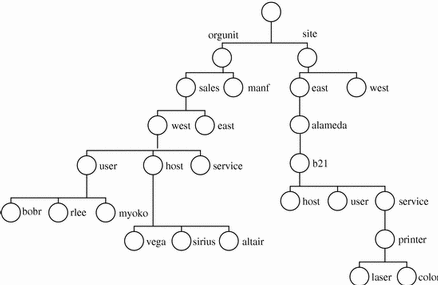Structure of the Enterprise Namespace
FNS policies define the structure of the enterprise namespace. The purpose of this structure is to allow easy and uniform composition of names. This enterprise namespace structure has two main rules:
-
Objects with narrower scopes are named relative to objects with wider scopes.
-
Namespace identifiers are used to denote the transition from one namespace to the next.
Table 22-2 is a summary of FNS policies for arranging the enterprise namespace. Figure 22-2 shows an example of a namespace layout that follows these FNS policies.
Table 22-2 Policies for the Federated Enterprise Namespace|
Namespace Identifiers |
Subordinate Namespaces |
Parent Context |
Namespace Organization |
Syntax |
|---|---|---|---|---|
|
orgunit _orgunit org |
Site, user, host, file system, service |
Enterprise root |
Hierarchical |
Dot-separated right-to-left |
|
site _site |
Service, file system |
Enterprise root, organizational unit |
Hierarchical |
Dot-separated right-to-left |
|
user _user |
Service, file system |
Enterprise root, organizational unit |
Flat |
Solaris login name |
|
host _host |
Service, file system |
Enterprise root, organizational unit |
Flat |
Solaris host name |
|
service _service |
Application specific |
Enterprise root, organizational unit, site, user, host |
Hierarchical |
/ separated left-to-right |
|
fs
_fs |
None |
Enterprise root, organizational unit, site, user, host |
Hierarchical |
/ separated, left-to-right |
|
printer |
None |
Service |
Hierarchical |
/ separated left-to-right |
Figure 22-2 Example of an Enterprise Namespace

The namespace of an enterprise is structured around a hierarchy of organizational units. Names of sites, hosts, users, files, and services can be named relative to names of organizational units by composing the organizational unit name with the appropriate namespace identifier and object name.
In Figure 22-2, a user myoko in the west division of the sales organization of an enterprise is named using the name orgunit/west.sales/user/myoko.
Note the use of the namespace identifier user to denote the transition from the orgunit namespace to the user namespace. In a similar fashion (with the use of appropriate namespace identifiers), names of files and services can also be named relative to names of sites, users, or hosts. Names of sites can be named relative to organizational unit names.
The goal of easy and uniform composability of names is met using this structure. For example, once you know the name for an organizational unit within an enterprise (for example, orgunit/west), you can name a user relative to it by composing it with the user namespace identifier and the user's login name to yield a name such as orgunit/west/user/josepha.
To name a file in this user's file system, you can use a name like orgunit/west/user/josepha/fs/notes.
- © 2010, Oracle Corporation and/or its affiliates
